How To Clean Your Hair Brush Easily – A Step-By-Step Guide
Because keeping your brush washed and cleaned properly can help avoid excess dirt in your mane.
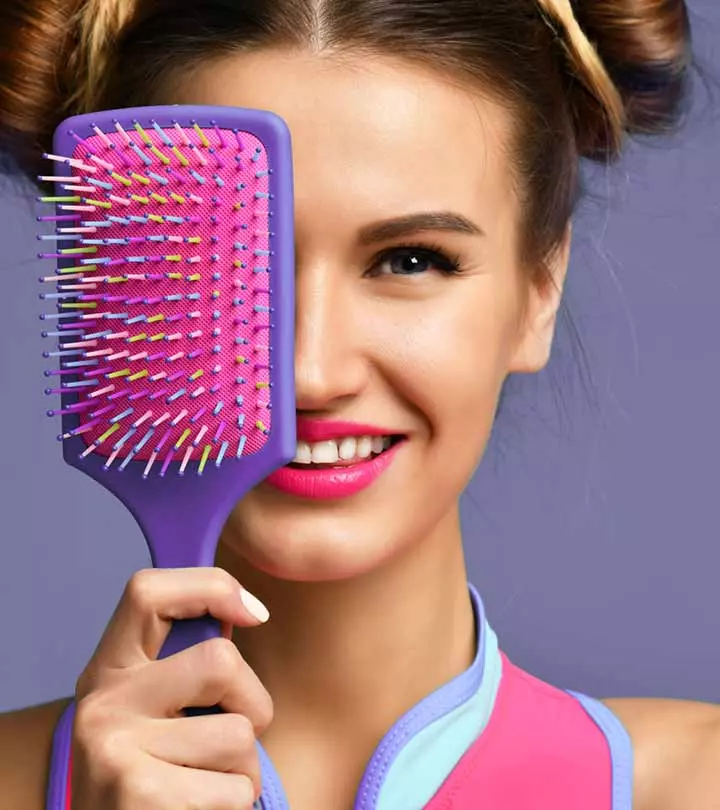
Image: ShutterStock
You may use high-end hair care products to pamper your hair with utmost care. But your efforts will go in vain if you use an unclean hairbrush. You must clean your hairbrush regularly as it collects product residue, excess oil, grime, dirt, and broken hair strands. In addition, a hairbrush can be the breeding ground for several germs – and warrants regular cleaning and maintenance. This article discusses the most effective ways to clean your hairbrush. Continue reading.
 Trivia
TriviaIn This Article
Why Should You Clean Your Hair Brush?
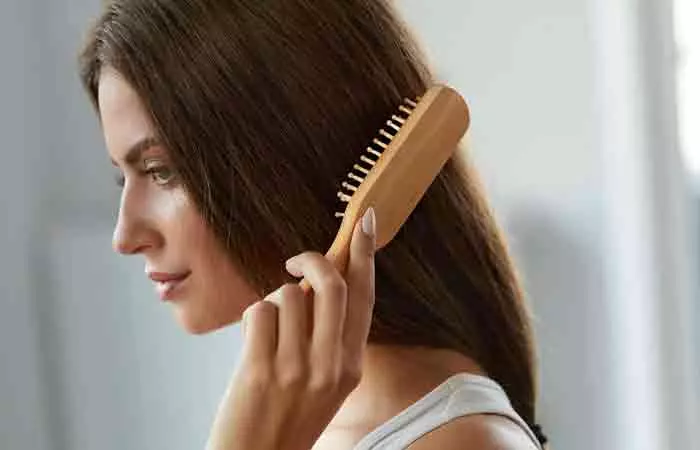
The major reason to clean your hair brush regularly is to stay healthy and hygienic. Unclean hair brushes are filled with dirt, natural oils, sweat, dead skin cells, product buildup (leave-in conditioners, gels, and hairsprays), microbes (yeast, bacteria, dust mites, and lice), and hair strands.
Hair accessories and brushes become breeding grounds for microbes like bacteria and fungi (yeast) if we do not clean them properly. They transfer grime and germs to your hair, compromising hair and scalp health. This also results in swelling, itching, and dandruff and may lead to folliculitisi A skin condition caused by bacteria that is characterized by itchy, sore, and inflamed bumps forming around the hair follicles. and seborrheic dermatitis.
Also, the hair brush will not be effective in detangling and brushing your hair. The process of brushing might get painful, leading to hair breakage.
Now that you know how important it is to clean hair brushes, let us move on to the next section that talks about how to clean hair brushes.
Key Takeaways
- It is essential to clean your hair brush because unclean brushes accumulate dirt, oil, dead cells, and microbes over time.
- You can use clarifying shampoo, liquid soap, or baby shampoo to clean hair brushes.
- If the bristles of your brush are wobbly, separated, or missing, it is time to throw it out and get a new one.
How To Clean A Hair Brush
1. Remove The Hair
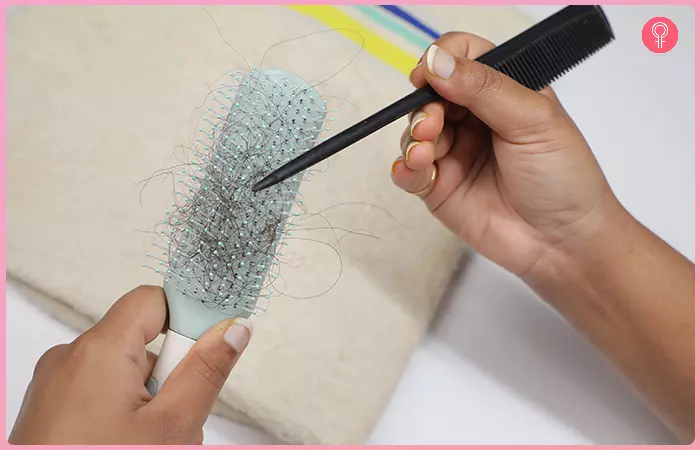
You stroke the hair sideways or vertically while grooming, which means matted hairi Loose hair that twists around the attached strands and results in tangled hair that cannot be fixed easily by a brush or comb. or foreign matter will get logged in the brush horizontally. Thus, the most important step is to remove all the hair tangled from the brush or comb.
Try to prong out the hair with a toothbrush, toothpick, chopstick, pen, or even the end of a rat-tail comb. A hair pick is best for cleaning wide-spaced, ball-tipped bristles.
You may notice that the hair may be knotted within the bristles. Use scissors to cut the hair stuck between the bristles into smaller pieces. This will not only make hair removal easy but also protect the bristles from separating or getting damaged. You can turn the brush bristle side down and use a toothbrush to clean lint, dust particles, and grime.
Note: You can use any narrow, sharp-edged item that fits between the bristles of the hair brush.
2. Wash The Brush
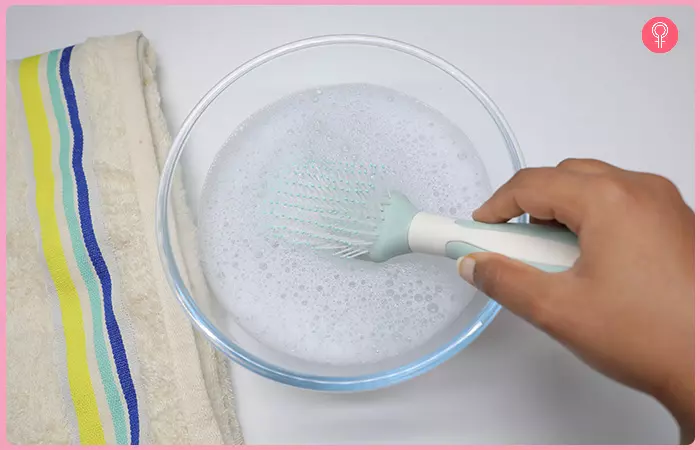
- A large bowl
- Warm water
- Clarifying shampoo or baking soda
- An old toothbrush, towel, or napkins
Steps
- Add shampoo (dime size or approximately 10 ml) to a bowl of warm water. You can also use your sink instead of a bowl.
- Mix thoroughly to form lukewarm sudsy water. Soak the unclean hair brushes and combs in the warm, soapy water. Depending on the type of hair brush, the soaking duration and cleaning solution will vary.
- Swish the hair brush around the bowl to remove debris.
- Scrub between the bristles gently with a toothbrush. You can also massage the bristle tips with your palms.
- Rinse the bristles thoroughly with warm water.
- Remove excess moisture by patting it dry with a towel or napkin.
Note:Do not soak the hair brushes for a long time or use harsh detergents as the glue that holds the bristles might melt.
3. Dry The Brush
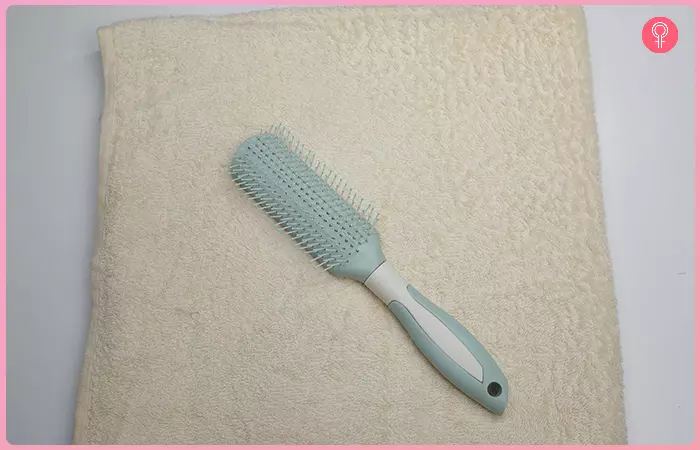
This is an important step to ensure no moisture is left on the hair brush. A moist and damp environment might cause microbial growth. The hair brush will also smell damp and musty if it is not dry completely. In the case of wooden hair brushes, water also increases the risk of wood rotting.
Turn the brush bristle side down on a towel or hang off the edge of the counter. Do not dry hair brushes vertically as it might loosen the bristles.
Anitha Mallya, a blogger, shared her personal experience and how she prefers cleaning her hair brushes effectively. She talks about the simple methods in her blog post. While talking about getting all the hair out from the comb, she said, “I used toothpicks, scissors anything small and flat that can get through the bristles to the base of the comb (i).” She shares the results, “Next morning, Tada!!! My brush was back to its former glory. I was so happy to see it clean and shiny.”
 Quick Tip
Quick TipFollowing the section on how to clean a hair brush, let’s move on to the next topic. Think about it, can we clean all hair brushes in the same way? Probably not! Simple tweaks will help you clean different types of brushes without damaging them. Scroll down to learn more.
How To Clean Different Types Of Hair Brushes
| Type Of Brush | Method |
| Thermal Brush | Wipe with a soft fiber cloth. You can also dampen the cloth and wipe the brush with it. Do not soak this type of hair brush in water. |
| Natural Bristle Brush | Soak the brush in a mixture of warm water, clarifying shampoo, and tea tree oil (2 to 3 drops) for not more than 10 minutes. |
| Nylon Bristle Brush | Soak the brush in a solution of warm water and baby shampoo for 15 minutes. |
| Mixed Bristle Brush | Soak the brush in warm soapy or shampoo water for 10 minutes. Use castile soap or baking soda for better results. |
| Detangling Brush | Soak the brush in a mixture of warm water and clarifying shampoo for 10 minutes. |
| Paddle Brush | Soak a plastic paddle brush in warm sudsy or mild shampoo water for 10 minutes. For a wooden paddle brush, dip a toothbrush in the cleaning solution and scrub the bristles. |
| Wooden Round Brush | Pour a mixture of warm water, soap, and tea tree oil (2 to 3 drops) on the bristles. Lay it on a towel to dry. Do not wet the wooden part to prevent damage. |
| Metal Round Brush | Soak the brush in a mixture of lukewarm water, shampoo, and baking soda. |
| Curved Brush | Soak the brush in warm soapy or mild shampoo water for 10 minutes. |
| Cushion Brush | Submerge the brush’s bristles in warm soapy water for 5 minutes to loosen dirt and hair. |
| Vented Brush | Submerge the bristles of the brush in warm soapy water and swish around a few times. |
| Teasing Brush | Dip a toothbrush in a warm shampoo solution and scrub the hair brush base. |
| Rat-tail Brush | Soak the brush in a bowl of warm water and baby shampoo for 10 minutes. Use a toothpick or pen to dislodge any hair or debris stuck between the teeth. |
Some other cleaning agents you can use to clean your hairbrush are hydrogen peroxide and ammonia.
How To Clean Hair Brushes With Hydrogen Peroxide?
Hydrogen peroxide helps sanitize the brush and remove oils, dirt, and bacteria, promoting healthy hair and scalp hygiene. You can easily use hydrogen peroxide to wash your hair brush. Soak your hair brush in a 1:1 ratio of hydrogen peroxide and water or in a 3% hydrogen peroxide solution for about 10-15 minutes. Then scrub off the comb with an old toothbrush to remove any dirt. Wash the brush again with a mild soap to get rid of any stubborn residue.
How To Clean Hair Brushes With Ammonia?
Mix one part of ammonia with four parts of warm water in a clean bucket. Leave your brush to soak for 10 minutes before scrubbing it clean. Then rinse it thoroughly to remove any residue of the solution.
On average, cleaning your hair brushes once a week should suffice. However, this depends on various factors. The next section explains what they are.
How Often Should You Clean Your Hair Brush?
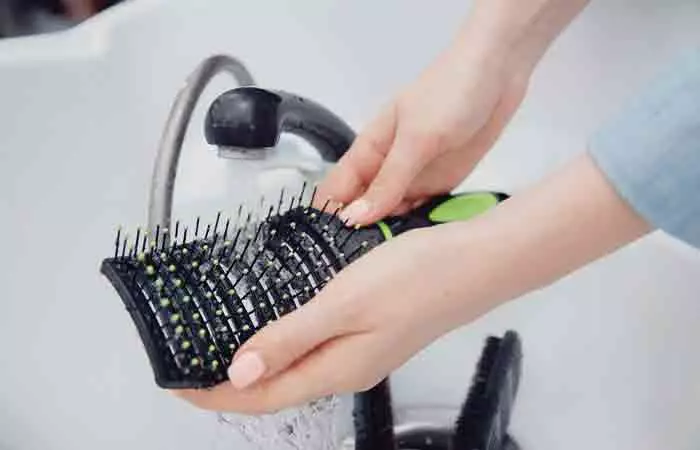
- Excessive Hair Breakage: If you have damaged hair or are experiencing excessive hair fall, chances are your hair brush is always filled with hair. Dry and damaged hair tends to get stuck in the brush easily. This is also observed in people with naturally textured or curly hair.
Note:
Remove the hair stuck between the bristles after brushing to prevent the brush from collecting more hair.
- Overactive Glands: If you have a sweaty or oily scalp, your hair brush will get dirty with gunk, grime, and greasiness frequently. Clean your hair brush at least once a week to get rid of dirt, dead skin cells, and residue from hair products.
- Product Buildup: If you use hair styling products, such as styling creams, dry shampoos, gels, hair mousse, or hair sprays, clean your hair brushes and combs every time you wash your hair. This ensures that your clean hair does not get contaminated by the product residues from dirty hair brushes. Additionally, there are seasons when heavy hair products are more commonly used, like sunscreen-infused sprays for the summer or intense moisturizers for winter for intense moisturizers. This may cause your brushes to accumulate buildup faster. So, you should clean your brushes more frequently to maintain healthy hair and scalp hygiene.
Although soap and water are enough to clean your hair brushes, there are other substitutes to keep your hair brushes squeaky clean. Check out the following section.
What Should You Use to Clean Your Hair Tools?
- Clarifying Shampoo: This shampoo is specifically formulated to eliminate oily residue and grime from the scalp and will clean hair brushes easily.
- Liquid Soap: Use castile soap to dissolve the sticky debris from the hair brush. Castile soap is natural and free of chemicals.
- Baby Shampoo: Baby shampoos are gentle and a great alternative to clean hair tools, such as hair brushes and combs.
- Baking Soda: Add a tablespoon of baking soda to your shampoo before you clean the hair brushes. It is natural, non-toxic, and an effective home remedy for dirt removal.
- Disinfectants: Salons and parlors use industrial-strength disinfectants as their hair tools are used extensively. Also, a UV light-based hair brush sanitizing device has been patented recently to get rid of microbes (1).
Are you using your hair brush past its prime? It is recommended to replace your hair brushes every couple of years. We have a checklist to help you know when it is time to buy a new hair brush. Scroll down to know more!
How Do You Know It Is Time To Replace Your Hair Brush?
Check for the following aspects:
- Is it missing bristles?
- Are the bristles separated?
- Are the bristles wobbly?
- Is the handle or ferrule loose or wearing?
- Is the cushion pad deflated?
If you answer yes to any of the above, go ahead and replace your hair brush.
Infographic: How To Wash Your Hair Brush
Cleaning your hair brush boosts the hygiene and health of your hair and scalp. You should clean your brush or comb at least once every two weeks to avoid any hair and scalp issues. Check out the infographic below to learn the steps you should follow to properly clean your brush.
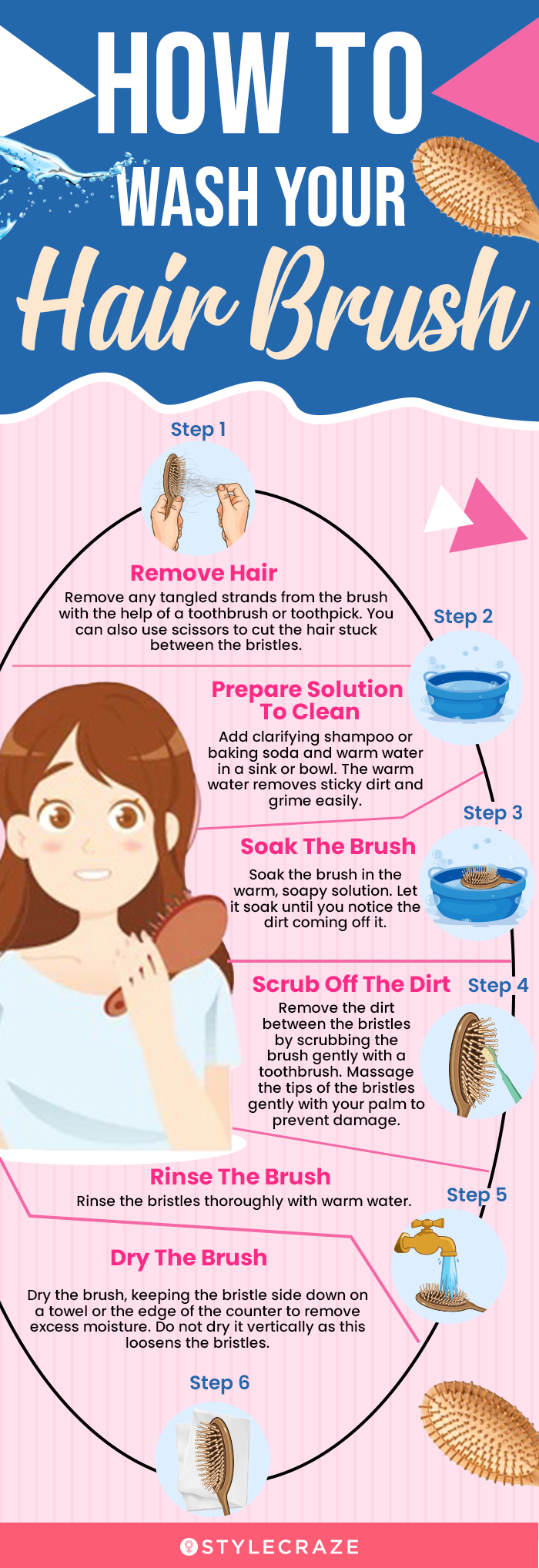
Illustration: StyleCraze Design Team
All your hair care efforts go wasted if you do not clean your hairbrushes regularly and maintain proper hygiene. This habit helps maintain your hair health and prevents scalp infections and irritation. Using an unclean hairbrush causes itching, flaking, swelling, and cause skin conditions like seborrheic dermatitisi A typical scalp infection of inflamed skin with scaly patches and dandruff in the oily areas like the face, nose, eyebrows, ears, eyelids, and chest. . You may use simple household items like shampoos, soaps, or baking soda to clean your hairbrushes. Also, remember to replace the brushes, depending on the condition of the bristles. Follow the tips mentioned above to achieve healthy, lustrous, and strong hair.
Frequently Asked Questions
Can a dirty hair brush cause hair loss?
Dirt buildup on hair brushes can affect hair and scalp health. A dirty hair brush can make your scalp dirty even after a hair wash. If this continues, both your scalp and hair can get damaged. This, in turn, results in hair loss.
How often should I replace my wet brush?
Frequent use of your wet brush can shorten its lifespan. In general, you should replace your hair brush every six months to one year.
Can old brushes cause dandruff?
Yes. When you use any old or dirty brush, it not only leads to hair breakage but also makes your scalp itchy and prone to dandruff.
Can a dirty hair brush cause greasy hair?
If you don’t clean your hairbrush regularly, the excess oil, dirt, and product buildup stick to your hair. Using the same unclean brush often can turn your hair greasy.
Does brushing hair make it oilier?
Brushing your hair has various unique benefits, such as distributing natural oils from your hair roots, nourishing them, and imparting a healthy shine. However, learning to do it properly is crucial to garner its maximum benefits.
Illustration: How To Clean Your Hair Brush Easily - A Step-By-Step Guide

Image: Dall·E/StyleCraze Design Team
Learn how to clean your hair brushes the right way! Get rid of lint and dirt with this easy step-by-step guide. Watch this video now to keep your brushes looking like new!
Personal Experience: Source
StyleCraze's articles are interwoven with authentic personal narratives that provide depth and resonance to our content. Below are the sources of the personal accounts referenced in this article.
i. How to: Clean Hair brusheshttps://anithamallya.wordpress.com/2013/06/02/how-to-clean-hair-brushes/
References
Articles on StyleCraze are backed by verified information from peer-reviewed and academic research papers, reputed organizations, research institutions, and medical associations to ensure accuracy and relevance. Read our editorial policy to learn more.
- Hair brush sanitizing unit
https://patents.google.com/patent/US10058169B2/en
Read full bio of Yvey Valcin
Read full bio of Annie Jangam
Read full bio of Eshna Das
Read full bio of Monomita Chakraborty






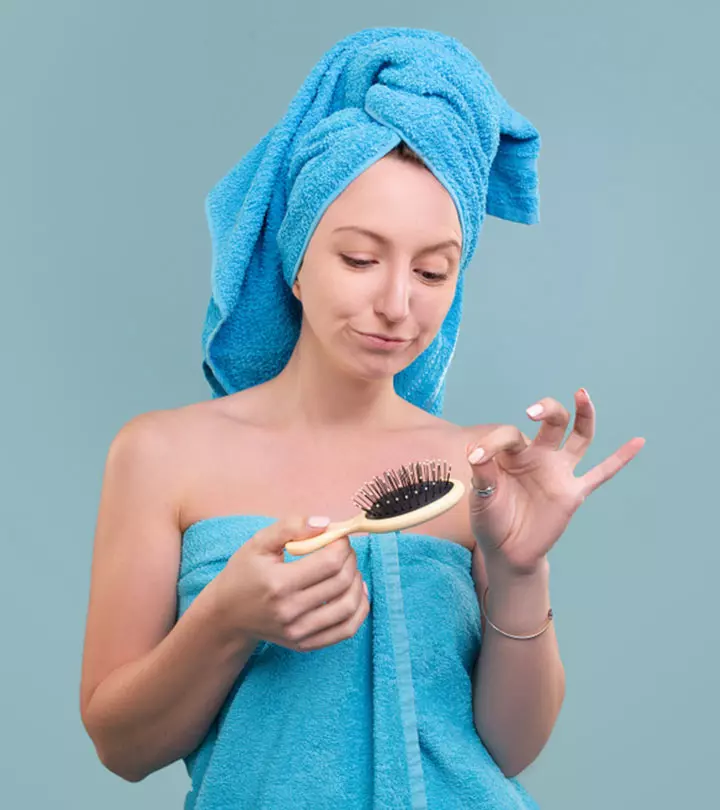
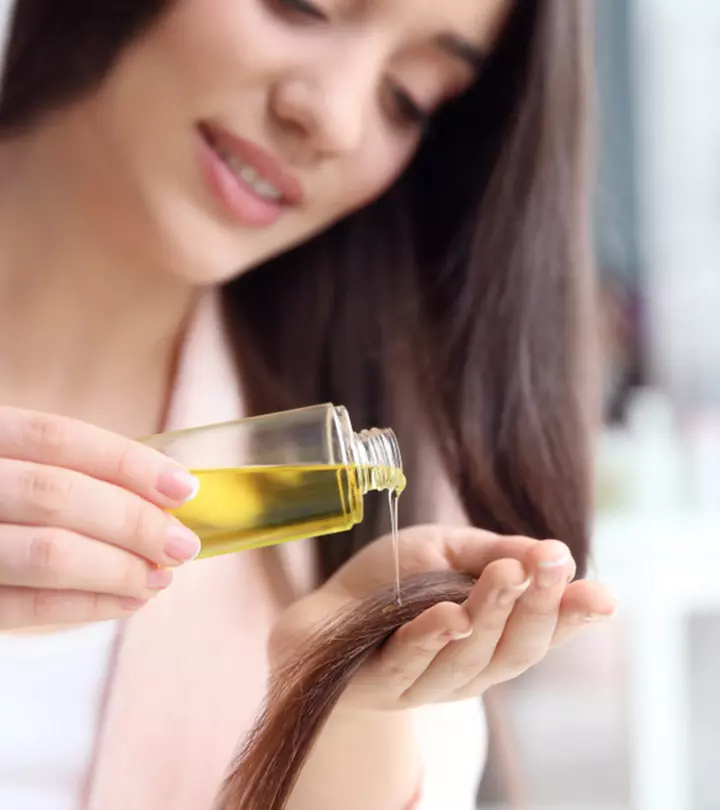

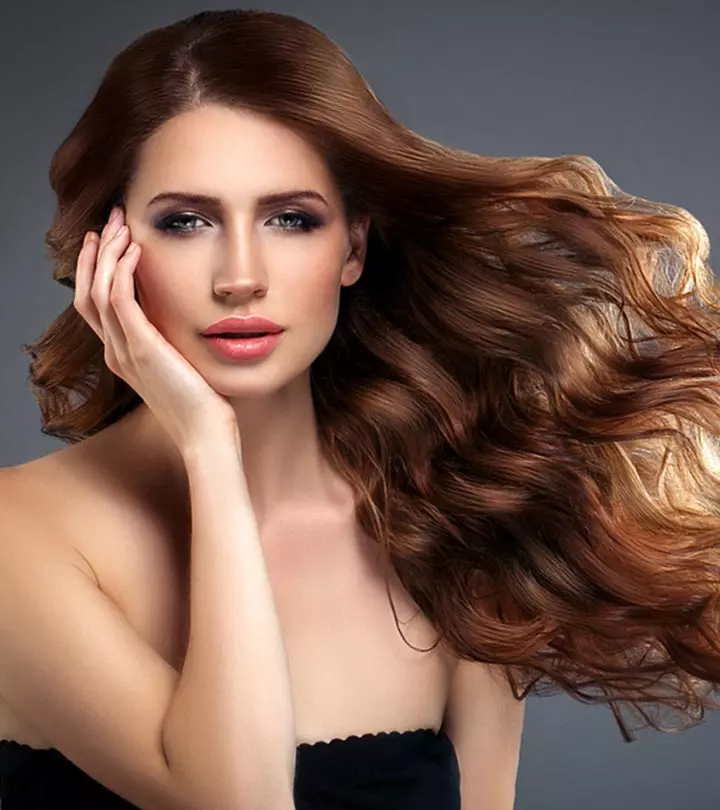
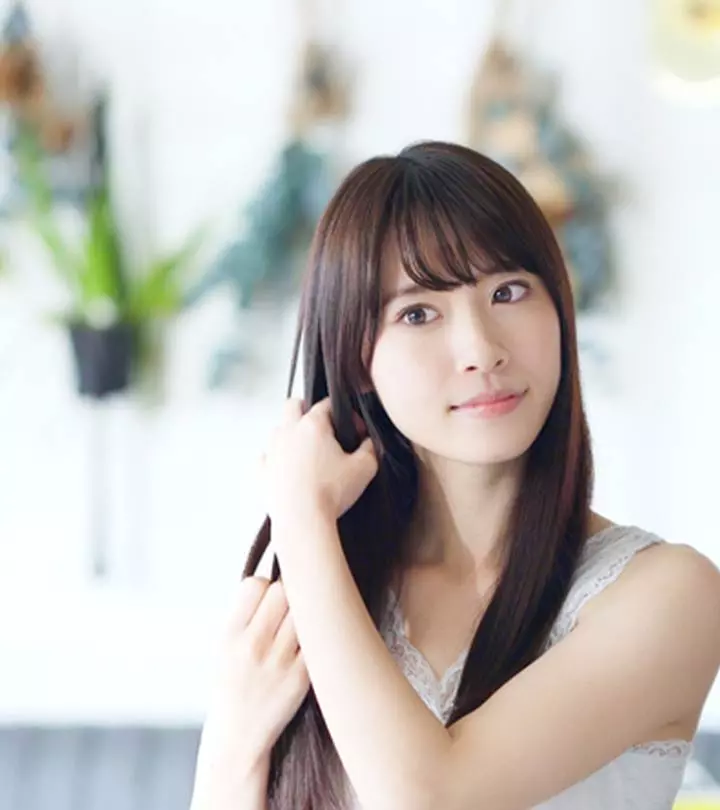

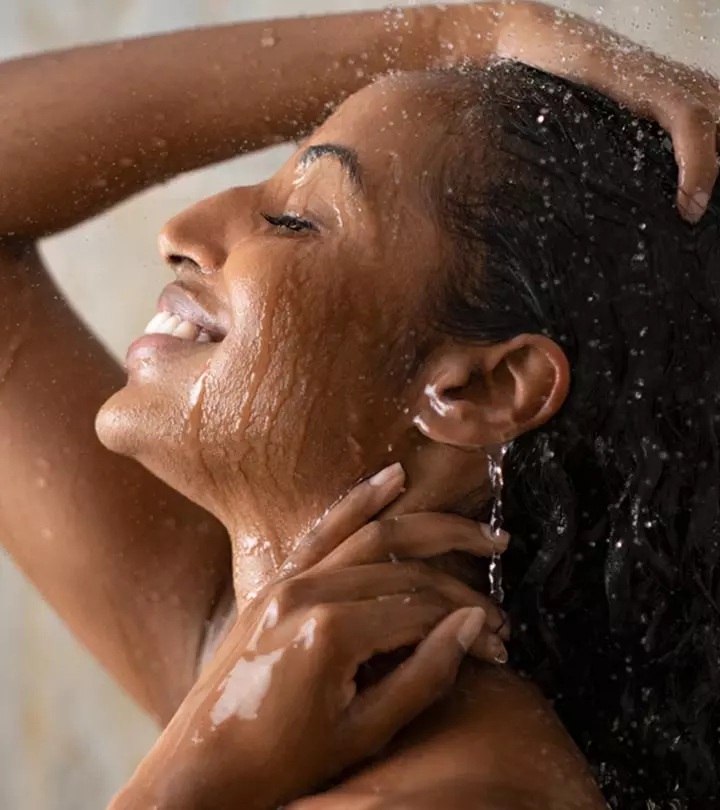
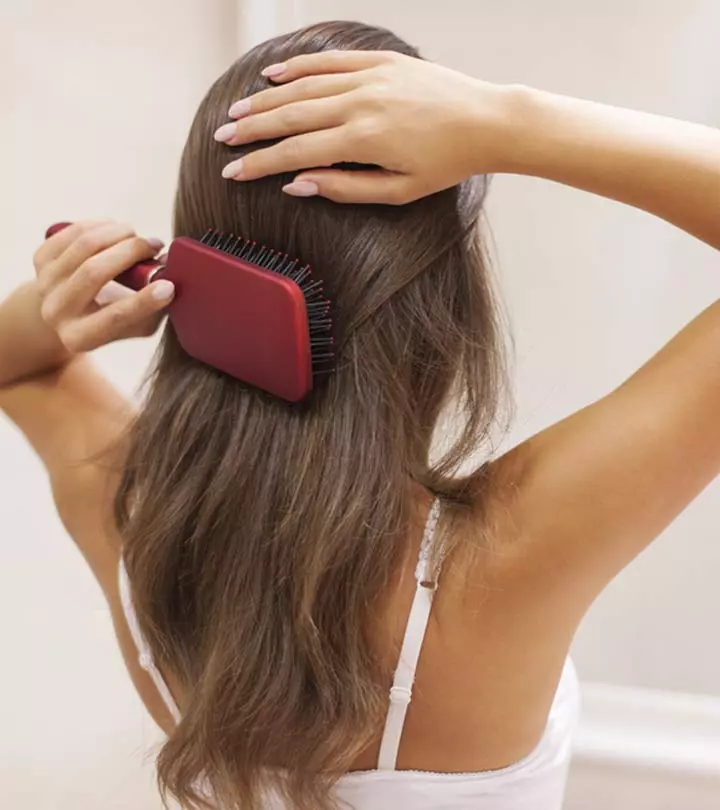
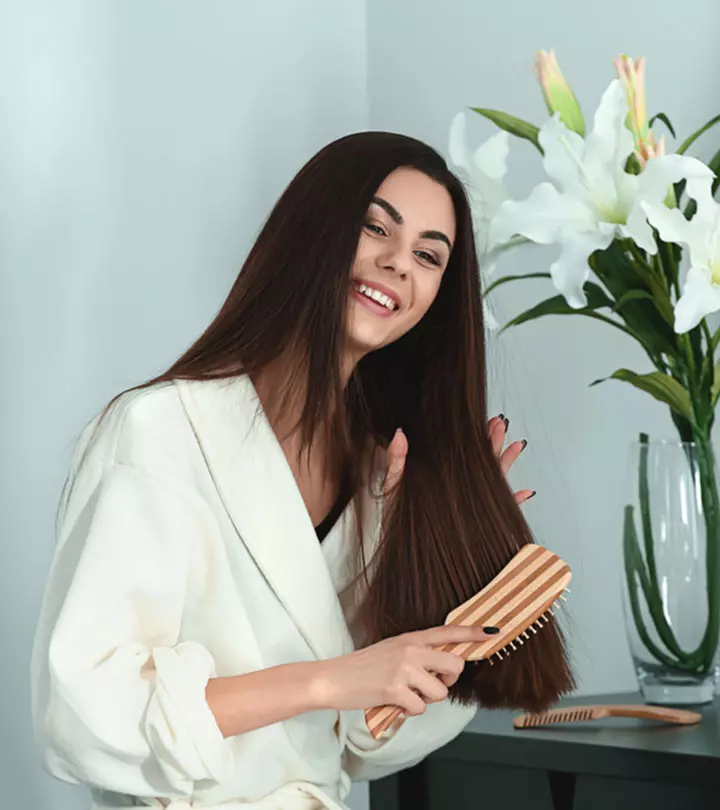
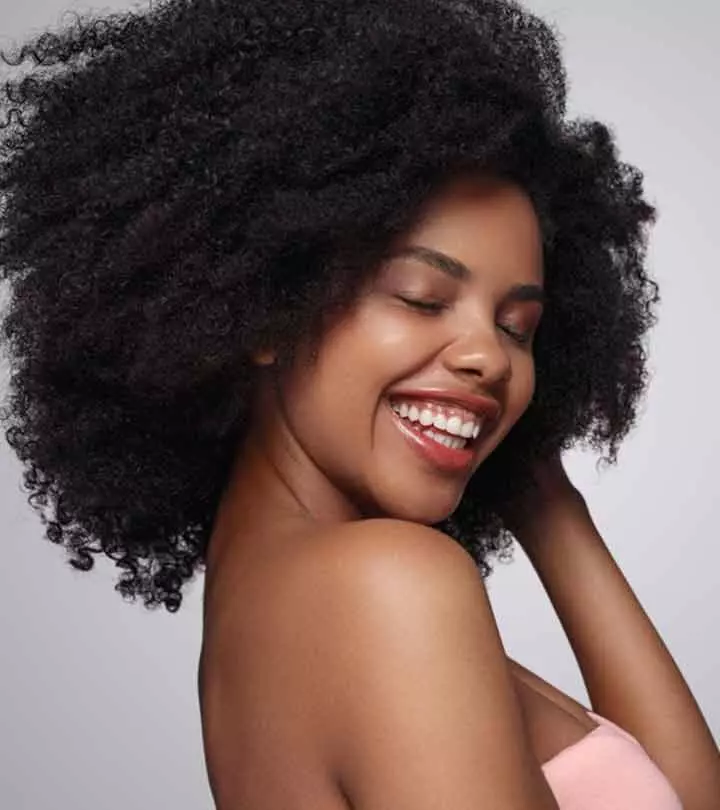
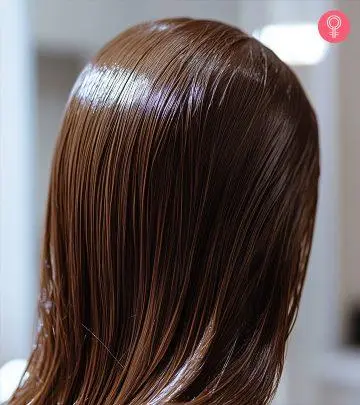

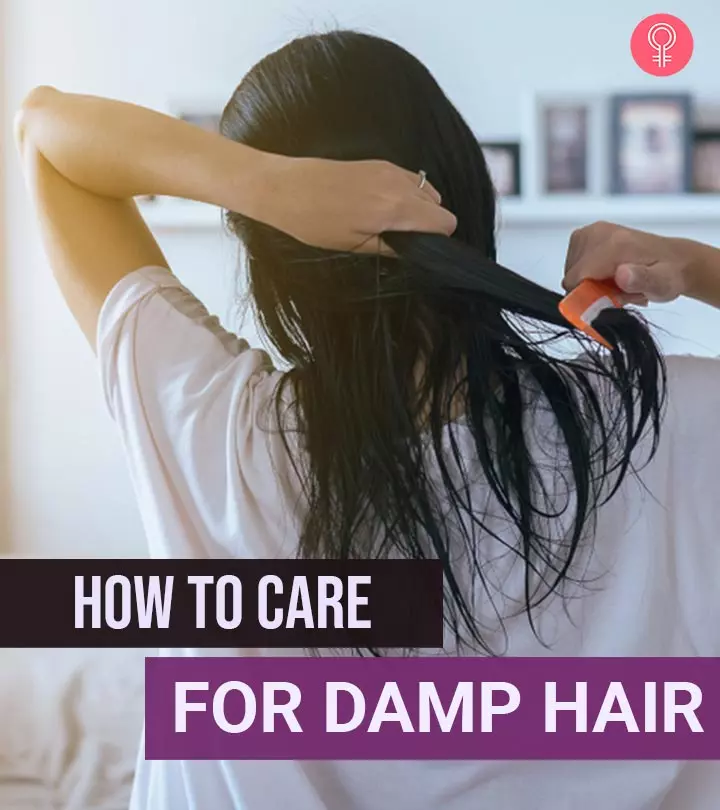
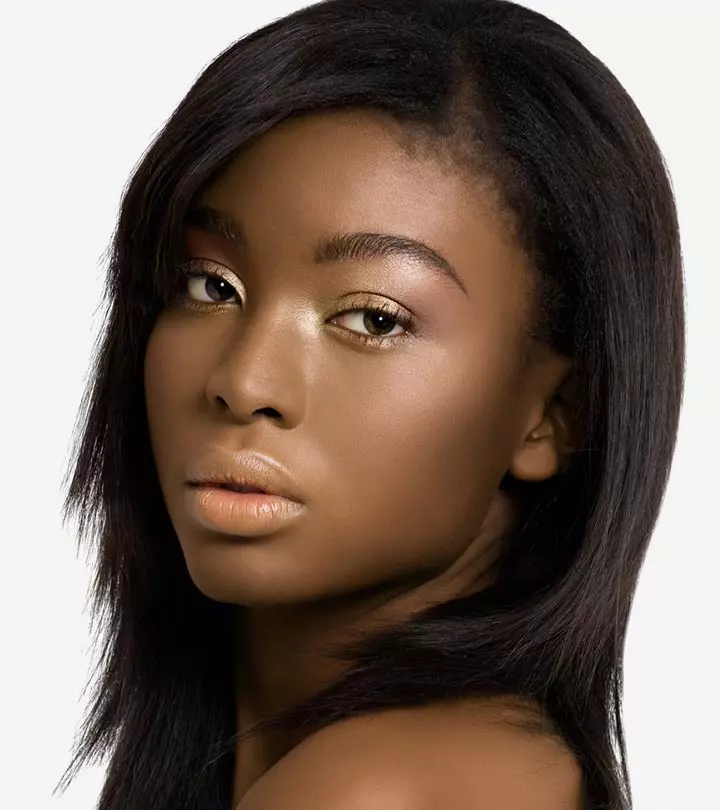

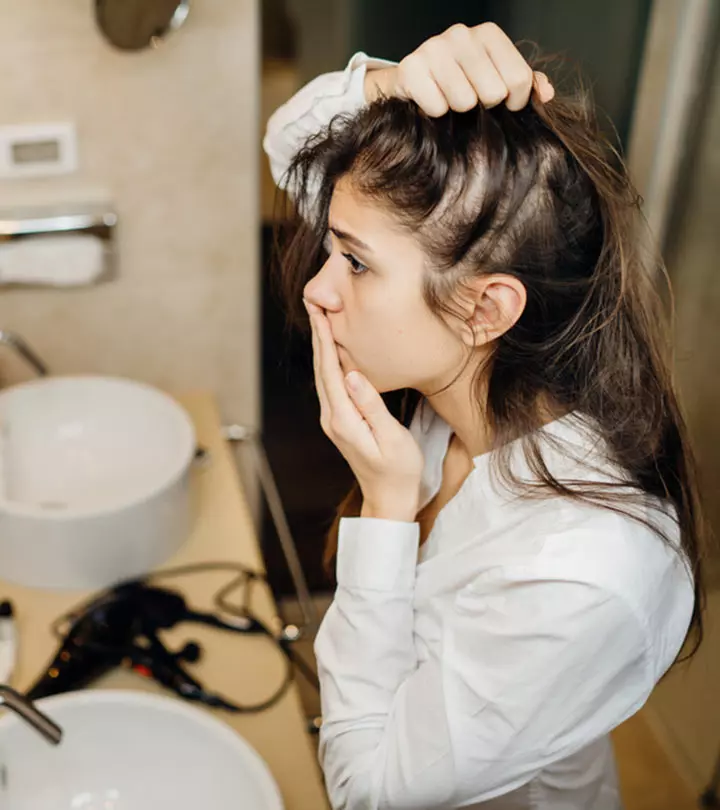
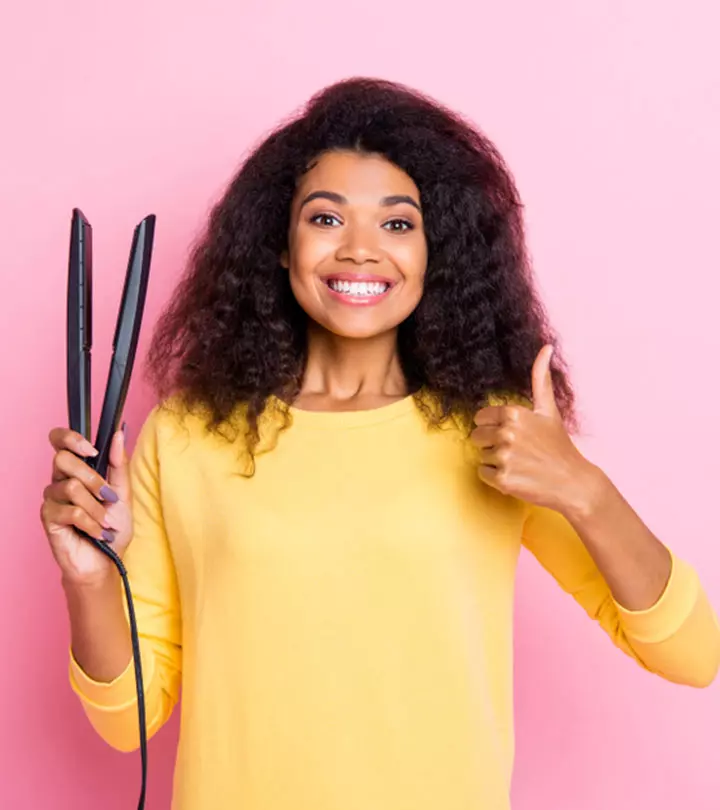
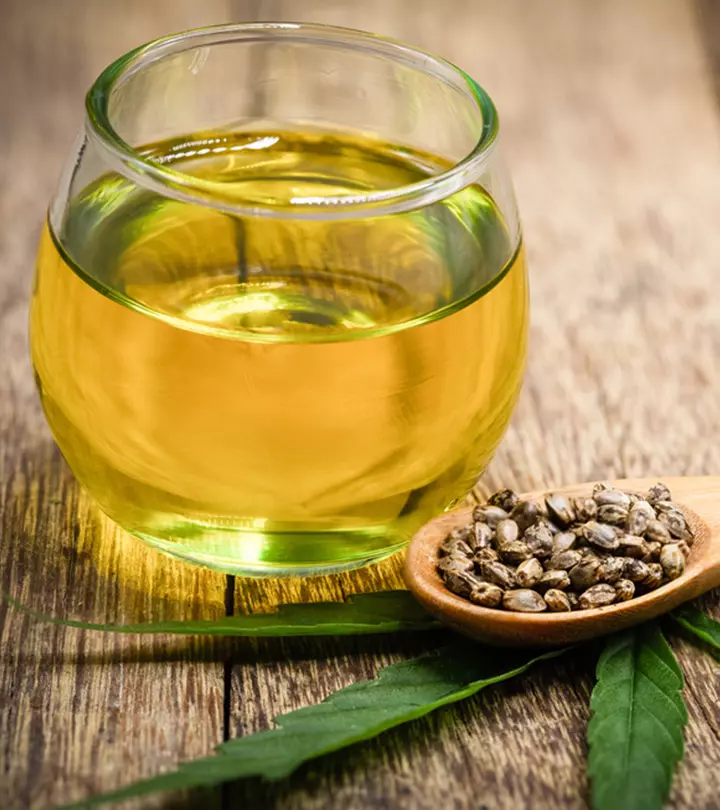
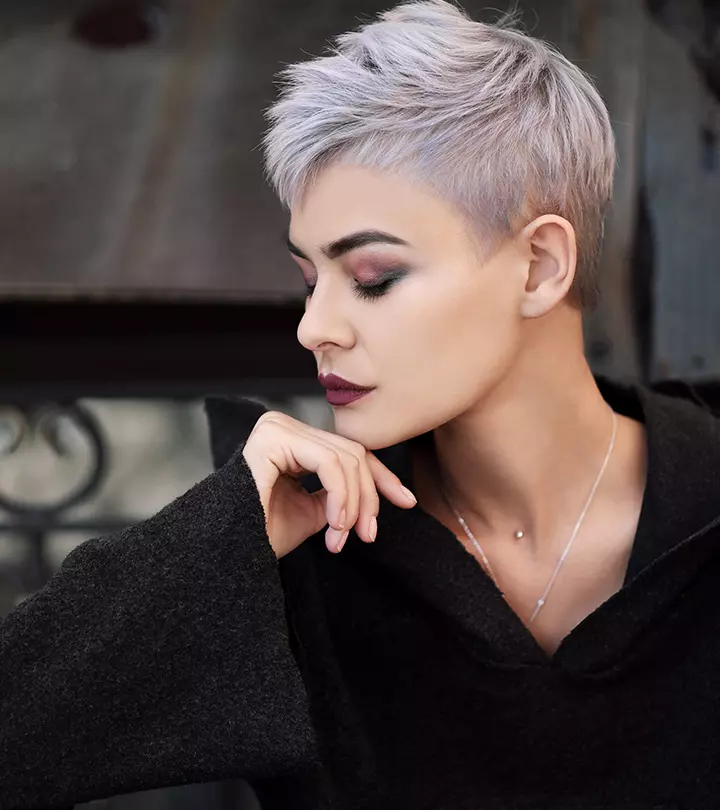
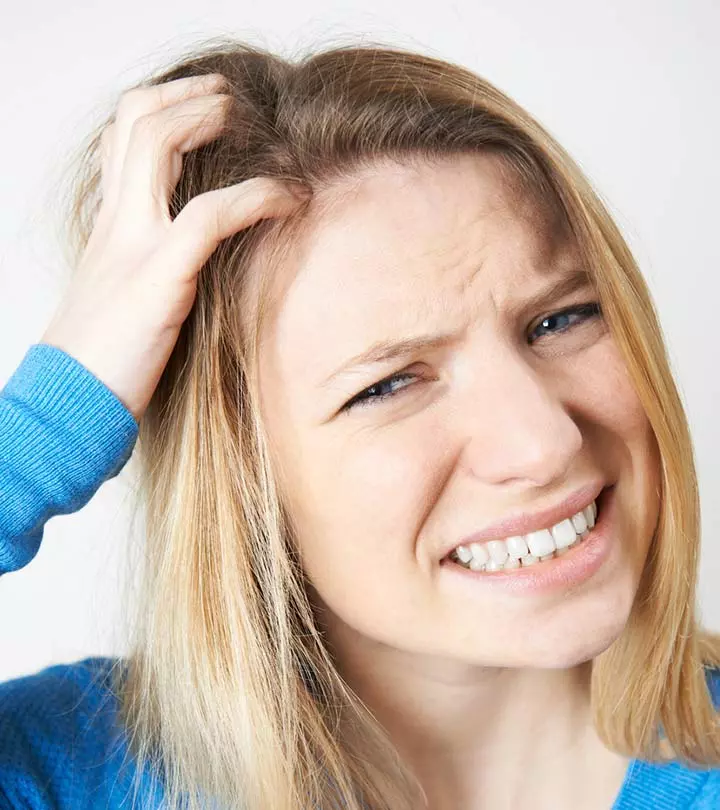
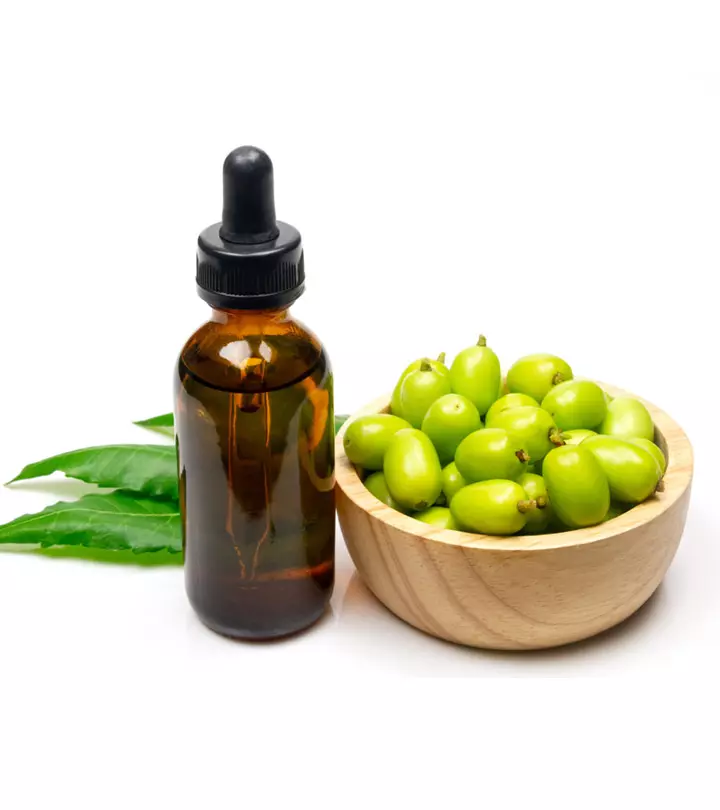
Community Experiences
Join the conversation and become a part of our empowering community! Share your stories, experiences, and insights to connect with other beauty, lifestyle, and health enthusiasts.